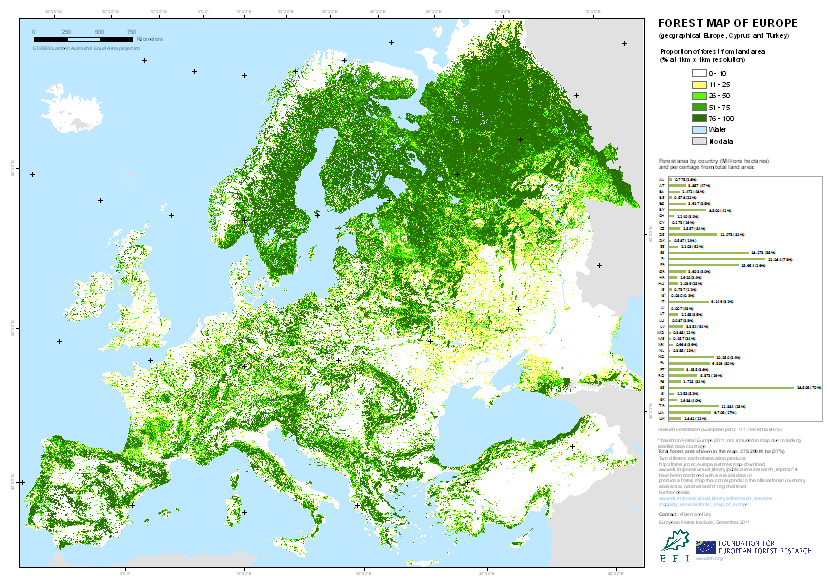Forest Map of Europe


Marcus Rodriguez
Historical Geography Expert
Marcus Rodriguez specializes in historical cartography and geographic data analysis. With a background in both history and geography, he brings unique...
Geographic Analysis
What This Map Shows
The "Forest Map of Europe" provides a comprehensive visualization of forest coverage across the continent. It highlights the vast expanses of wooded areas, showcasing the distribution of different forest types, including coniferous, deciduous, and mixed forests. From the dense boreal forests of Scandinavia to the Mediterranean woodlands of southern Europe, this map serves as a crucial tool for understanding the ecological landscape of Europe.
Deep Dive into European Forests
Forests cover approximately 43% of Europe's land area, making them vital components of the continent's environment. They play a crucial role in carbon sequestration, biodiversity conservation, and the provision of ecosystem services. Interestingly, Europe has a diverse range of forest types due to its varied climate and geography. For instance, the northern regions, particularly the Nordic countries, are dominated by boreal forests primarily composed of conifers such as spruce and pine. These forests are not only crucial for wildlife habitat but also serve as significant carbon sinks, helping to mitigate climate change.
In contrast, Central and Southern Europe showcase a mix of deciduous and mixed forests. The broadleaf forests, which include species such as oak, beech, and chestnut, contribute to a rich biodiversity that supports various animal species, from deer to numerous bird species. The Mediterranean regions, characterized by a warmer climate, host unique ecosystems including cork oak forests and maquis shrublands, which are adapted to withstand dry summers.
What's fascinating is that Europe's forests are not just ecological treasures; they also have significant economic implications. The forestry industry is vital for many European countries, providing jobs and resources ranging from timber production to recreational opportunities. Countries like Finland and Sweden lead in sustainable forest management practices, balancing economic needs with ecological health. However, challenges such as deforestation, forest fragmentation, and climate change threaten these vital ecosystems.
Regional Analysis
When analyzing the forest coverage by regions on the map, notable variations emerge. The Scandinavian countries, particularly Norway, Sweden, and Finland, boast some of the highest percentages of forested land, often exceeding 70%. This extensive forest coverage is crucial for their economies, supporting timber industries and tourism.
Conversely, countries in Southern Europe, such as Greece and Italy, have lower forest coverage, often below 30%. The Mediterranean climate presents challenges for forest health, including susceptibility to wildfires and drought. Interestingly, forests in these regions are often fragmented due to urban development and agriculture, leading to biodiversity loss.
In Central Europe, nations like Germany and Austria have a balanced mix of both coniferous and deciduous forests, contributing to higher biodiversity levels. However, these areas also face pressures from industrialization and urban expansion, impacting their forest health.
Significance and Impact
Understanding Europe's forest distribution is crucial for several reasons. First, forests are essential for combating climate change, and preserving them can significantly contribute to global carbon reduction efforts. They also provide numerous ecosystem services, including water regulation, soil preservation, and habitat for wildlife.
Furthermore, as urbanization continues to expand, the need for sustainable forest management becomes increasingly important. Forests not only serve as recreational spaces for urban dwellers but also play a role in improving air quality and reducing urban heat island effects. Current trends indicate a growing recognition of the importance of reforestation and afforestation initiatives across Europe, with countries investing in restoring degraded landscapes.
In conclusion, the "Forest Map of Europe" is more than just a visual representation of wooded areas; it encapsulates the ecological, economic, and social dynamics of forests across the continent. As we look towards the future, the management and conservation of these forests will be paramount in addressing environmental challenges and ensuring a sustainable future for both nature and human societies.
Visualization Details
- Published
- August 11, 2025
- Views
- 40
Comments
Loading comments...